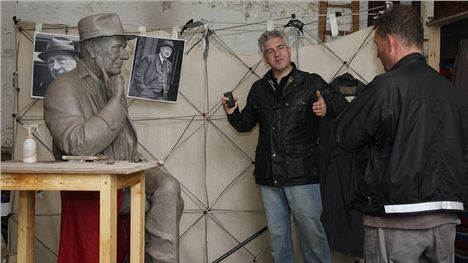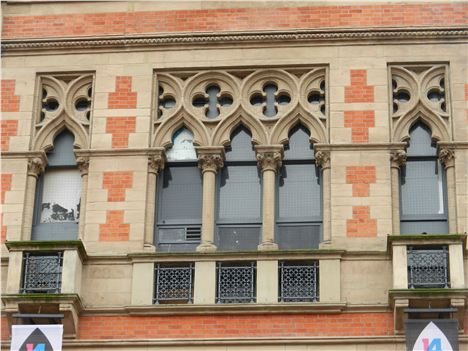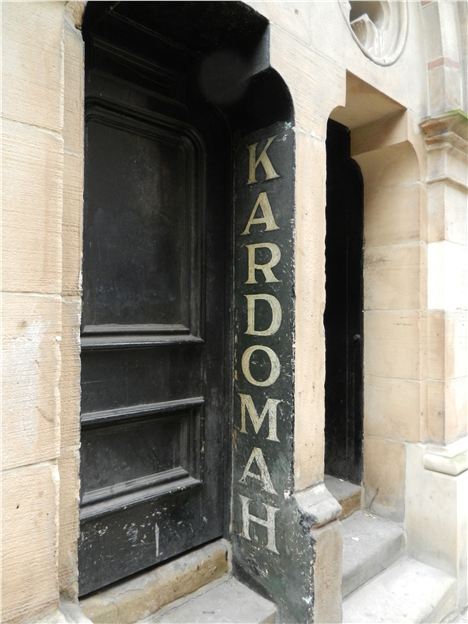THE MEMORIAL Hall was finished in 1866 and designed by Thomas Worthington. It was built to mark the moment in 1662 that Non-conformists (and thus all those later Methodists, Baptists, Congregationalists and so on) formerly asserted their identity and left the established Church of England.
Now those Manchester’s temples of food and drink worship, the Chop Houses, have bought the beautiful nineteenth century building. Sam’s and Thomas’s Chop Houses, collectively known as the Victorian Chop Houses, are moving in.
The Memorial Hall is a wonderful building in a wonderful place. Albert Square should be full of thriving businesses and independents, it should represent the best of Manchester.
In the fullness of time we’ll have Manchester’s most boutique of boutique hotels with six sharply appointed bedrooms.
That's for next year.
Before that and by Thursday 1 November there'll be a two floor restaurant and pub with between 140-180 covers. Above this there'll be a couple of first floor meeting rooms that can be converted into a single larger room for 105 diners or a drinks function of 150 people.
Purchase and fit out costs amount to £3.5m.
The food will be, as with the other Chop Houses, a modern interpretation of traditional British food.
 Ward Chatting Through One Of His Earlier Projects, The Statue Of LS Lowry Now Sat At The Bar Of Sam's Chop House
Ward Chatting Through One Of His Earlier Projects, The Statue Of LS Lowry Now Sat At The Bar Of Sam's Chop House
Victorian Chop House boss Roger Ward explains what happened.
“I was approached to see if we might be interested in taking the lease of the Memorial Hall by the developer Bill Wrather of Wrather and Co, a real gent. He wanted us to run a version of the Chop Houses in the building and he’d put office space above. A lift was going to be imposed in the Albert Square elevation and access to the restaurant would have been from Southmill Street.
“I didn’t think this would work for us. A restaurant and pub needed Albert Square access. I started to get ideas and then I started to fall in love with the building, so I asked Bill if he would sell it us instead.
"That was in January, we’ve now completed on the sale, we’ve got planning permission in at the moment, and if all goes well ( and we've talked to lots of people including English Heritage) I want to open in time for the Christmas markets which begin on 17 November, hence the 1 November deadline.”
So where is the business sense in this?
“The location first of all, then the fact the building fitted with what we do already. We’re frequently asked at the Chop Houses if we can put on events, weddings, business meetings and so on. This will give us the room to do that.
"On a more general note it was too good a site to lie fallow. The Memorial Hall is a wonderful building in a wonderful place. Albert Square should be full of thriving businesses and independents, it should represent the best of Manchester. Of course," says Ward pausing in full flow, "I’m also confident about getting the investment back.”
Ward is a Midlands man sensitive to the history and traditions of Manchester. He will be ensuring the heritage of the building is underlined and emphasised where possible.
The architect Thomas Worthington will have a suite dedicated to him while photographer Paul Wolfgang Webster has been taking pictures of every remaining Worthington building for a permanent exhibition of this master Manchester architect’s work.
After lying lifeless for the best part of ten years since the closure of the faded and dismal Square Albert pub, its heartening to see new use being given to this jewel of Manchester design.
As Ward speaks you can hear the pride in his voice as he repeats the words of English Heritage’s Julian Holder.
“He said it's certainly the most important building of its type in the North of England and possibly in the whole of the UK. Isn't that something?”
You can take a look at the Design Statement from architects HurdRolland here.
You can follow Jonathan Schofield on Twitter here @JonathSchofield
The Genius Of The Memorial Hall
Some buildings are landmarks and only work like that - Manchester Town Hall, the Imperial War Museum North.
Others have a quieter quality.
The Memorial Hall is a model of how to enrich a streetscape without dominating it, of how to dress well, stand out, without being vulgar or threatening.
Taking all the best qualities of the Venetian Gothic, as espoused by visionary, art critic and nutter, John Ruskin, Worthington effortlessly gathered these together and slotted them into an awkward site. He makes it look as though the style had been made for a Northern sky.
It is a sweet work. Eye-catching in its details, a polychromatic (multi-coloured) layering of red brick and sandstone, harmonious, lyrical, a festival of relief lettering, balconies, pointed arches and those glorious windows with the flowing tracery on the second floor, borrowed from the Golden House aka Ca d'Oro in Venice.
It's a shame that little remains of the original interior which has been destroyed in various ill-advised renovations.
The building aside from hosting various non-conformist committees was home to the Halle Orchestra choir for many years. The lower ground floor was a Kardomah cafe after WWII and is mentioned by Manchester's Booker prize winner Howard Jacobson, 'The Kardomah Café in which a character called Russian Dave demonstrated the art of chatting up women of any age in a voice much like Rasputin's.'
As for Thomas Worthington (1826-1909) his work lies spread across the region from Monton Green Unitarian Church to the City Police Courts (now Crown Courts) at the end of Canal Street, to the central block of Withington Hospital, to the old neglected Greengate Baths off Trinity Way in his hometown of Salford, to the Albert Memorial facing the Memorial Hall. He also designed in Liverpool, Carlisle, Oxford and elsewhere.
A Unitarian by belief and committed to social reform and improvement he was a pioneer architect for baths, hospitals and public buildings.
 Ruskinian inspiration leading to a borrowing of Ca d'Oro windows
Ruskinian inspiration leading to a borrowing of Ca d'Oro windows







